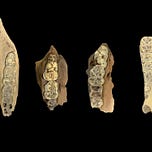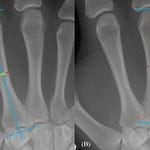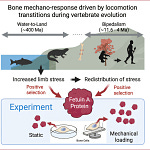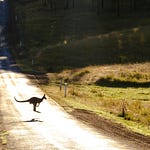In the humid wetlands of the Lower Yangtze, a quiet transition was underway some 8,000 years ago. Before formal pens, before selective breeding, before the clear skeletal signs of domestication, wild boars were already forging an uneasy alliance with humans. And the clues to this early intimacy are not in bones or buildings, but in the fossilized plaque on ancient pig teeth.
A new study published in Proceedings of the National Academy of Sciences1 examines this evidence with forensic precision. Using microfossil analysis of dental calculus—hardened plaque—from 32 pig specimens, researchers reconstructed diets, habitats, and even hygiene behaviors of pigs from two Neolithic sites: Jingtoushan and Kuahuqiao.
"Living with humans gave them easy access to food, so they no longer needed to maintain their robust physiques," notes Jiajing Wang, anthropologist at Dartmouth. "Over time, their bodies became smaller, and their brains also became smaller by about one-third."
Pig Teeth as Time Capsules
The team's approach sidesteps one of domestication archaeology's major limitations: relying on bone size and shape, which only reflect later stages of the process. The dental calculus offered something more immediate—trapped microscopic remains of what the pigs ate and what they encountered.
Among the finds: rice starch, yams, an unknown tuber, acorns, and wild grasses. But perhaps most telling were the remnants of whipworm eggs (Trichuris), a parasite exclusive to human guts. Their presence in pig mouths strongly suggests the animals were consuming human waste—either intentionally or through contaminated food or water.
"Pigs are known for their habit of eating human waste, so that is additional evidence that these pigs were probably living with humans or having a very close relationship with them," says Wang.
Wild, But Not Quite
Domestication doesn’t always begin in captivity. Many animals take what biologists call the "commensal pathway" into domestication—drawn by food, shelter, or waste, they loiter at the margins of human settlements. Over time, the friendliest or most tolerant individuals survive and reproduce.
The pigs at Jingtoushan and Kuahuqiao seem to embody this pattern. While still genetically wild, their behaviors and diets suggest close interaction with sedentary human groups. Dental measurements from several pigs even resemble those of modern domesticated pigs, hinting that selection pressures had already begun to reshape their bodies.
"What probably came first were behavioral changes, like becoming less aggressive and more tolerant of humans," explains Wang.
A Tale of Two Pathways
The findings support two models of early pig domestication:
Commensal pathway: pigs were not hunted and captured, but drawn to early farming villages by waste and food scraps.
Prey pathway: humans may have also deliberately managed wild boar populations, selectively harvesting and gradually domesticating them.
This dual dynamic blurs the line between wild and domestic. Some pigs scavenged. Others may have been penned, even partially fed. This mosaic of behaviors reflects the flexibility of both species.
Waste, Parasitism, and Disease
Beyond domestication, the study points to another consequence of early animal-human intimacy: shared diseases. Whipworm eggs in pig plaque highlight the health risks of cohabitation before sanitation.
"Our study shows that some wild boars took the first step towards domestication by scavenging human waste," says Wang.
This intimate proximity likely seeded early zoonotic exchanges, embedding animal parasites within human communities and vice versa.
Pig Roots in the Rice Fields
Both sites in the study, especially Kuahuqiao, had evidence of early rice agriculture. Stone tools and pottery show active food processing. The pigs' diets mirrored this shift. Their mouths, quite literally, became micro-archives of the Neolithic kitchen.
"We can assume that pigs do not cook food for themselves, so they were probably getting the food from humans either by being fed or scavenging," notes Wang.
The Domestication Threshold
Pig domestication in South China was not a clean break with the wild. It was a process—gradual, messy, and shaped by overlapping relationships. The pigs at these sites existed in a liminal zone: not fully wild, not fully domesticated, but already becoming something new.
Their teeth remind us that domestication wasn't always driven by intent. Sometimes it began in the trash heap, among scraps and feces, as wild animals found their way into human lives, kitchens, and cosmologies.
Related Research
Frantz, L. A. F., et al. (2019). Ancient pigs reveal a near-complete genomic turnover following their introduction to Europe. PNAS, 116(35), 17231–1738. https://doi.org/10.1073/pnas.1901169116
Cucchi, T., et al. (2011). Domestication and dispersal of pigs in the Neolithic and Iron Age of East Asia. Proceedings of the National Academy of Sciences, 108(1), 317–322. https://doi.org/10.1073/pnas.1008229108
Larson, G., et al. (2005). Worldwide phylogeography of wild boar reveals multiple centers of pig domestication. Science, 307(5715), 1618–1621. https://doi.org/10.1126/science.1106927
Wang, J., Tang, Y., Zheng, Y., Jiang, L., Ma, X., Hou, Y., & Sun, G. (2025). Early evidence for pig domestication (8,000 cal. BP) in the Lower Yangtze, South China. Proceedings of the National Academy of Sciences of the United States of America, 122(24), e2507123122. https://doi.org/10.1073/pnas.2507123122












